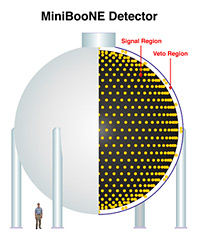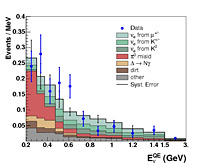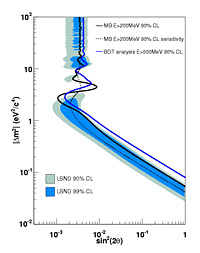MiniBooNE reports first antineutrino results
Despite enormous progress in the field of neutrino physics over the last two decades, numerous mysteries and basic questions about neutrino oscillations remain. This week, the MiniBooNE collaboration released a preliminary result that sheds more light on neutrino oscillations.
The MiniBooNE experiment explores the question whether muon neutrinos morph into electron neutrinos while traveling relatively short distances. In the 1990s, the Liquid Scintillator Neutrino Detector at Los Alamos National Laboratory seemed to have observed such a signal for antineutrinos. Based on results obtained with neutrinos, the MiniBooNE collaboration announced in April 2007 that its experiment could not confirm the LSND result. Instead, at neutrino energies lower than what would be expected under a simple two-neutrino mixing interpretation of LSND, MiniBooNE found a 3.7-sigma excess of electron neutrinos emerging from the primary beam of muon neutrinos.
This puzzling observation opened up the door for new questions. Is the low-energy excess observed by MiniBooNE in neutrino mode due to some misestimated background? Is it due to some new physics? Can it be related to the LSND anomaly observed for antineutrinos?
While theorists have been pondering possibilities, the MiniBooNE experiment has been busy collecting new data with a predominantly antineutrino beam. In this mode, data are acquired five times slower than in the neutrino mode because of a reduction in the overall antineutrino event rate.
Neutrino oscillations depend on the ratio L/E, where L is the distance from the neutrino source to the detector, and E is the energy of the neutrino beam. Relative to LSND, which reported an excess of antineutrino events for L/E from 0.4-1.2 m/MeV, MiniBooNE increased both L and E by an order of magnitude, keeping the ratio L/E fixed. Hence the neutrino transmutation due to simple neutrino mixing should be identical in both experiments, while the systematic errors of the two experiments are vastly different.
The 2007 MiniBooNE result was based on 5.6 x 1020 protons on target, thanks to the outstanding efforts of the Fermilab Accelerator Division. Since then, the MiniBooNE experiment has acquired an additional 0.9 x 1020 protons on target. The collaboration also has performed a detailed reanalysis of all neutrino data over the last year using the Fermilab Open Science Grid. The low-energy excess, from 200-475 MeV in neutrino energy (corresponding to L/E from 1.1-1.8 m/MeV), has persisted at a 3-sigma significance.
For the antineutrino mode, MiniBooNE now has analyzed the data from 3.4 x 1020 protons on target. On Thursday, Georgia Karagiorgi, MIT, the lead graduate student on the antineutrino oscillation analysis, presented the first results from a blind analysis. As shown in the figure above, the electron antineutrino signal candidates found in the data are in agreement with the underlying background prediction, even in the low-energy region.
Given the large low-energy excess observed in the neutrino data in 2007, the lack of a corresponding excess in the antineutrino data is quite intriguing. Systematic errors between the two data sets are highly correlated and many will cancel. A fully correlated analysis of the two data sets is in progress, but preliminary studies that assume no cancellation of systematic errors already heavily disfavor many types of explanations. For instance, a different estimate of the kaons produced at the target cannot reconcile the excess observed in neutrino mode without also producing an excess that should have been observed in antineutrino mode. More generally, any signal or background source where the cross section is expected to be the same for neutrino and antineutrinos cannot reconcile the two results. Proposals such as the axial anomaly interpretation by Harvey, Hill and Hill fall under this category.
Interpreting the MiniBooNE antineutrino result in the context of a two-neutrino mixing
hypothesis, the collaboration performed a fit to the reconstructed neutrino energy spectrum above 200 MeV, assuming that only antineutrinos can oscillate. The expected sensitivity and resulting limit from the fit are shown in the second figure. As is apparent in the graph to the right, the lack of statistical power of the antineutrino result precludes any strong conclusions with respect to the LSND signal. Due to a small excess and the shape of the reconstructed energy spectrum, the best fit point prefers to add a small signal. However, the 90-percent confidence limit taken about the best fit point includes nearly all of the LSND-allowed parameter space as well as the null hypothesis.
The single largest improvement that MiniBooNE can make to produce a more conclusive result is to gather more antineutrino data. The experiment is scheduled to run through the 2009 shutdown. This will increase its antineutrino data sample by 50 percent.
Result of the Week Archive
|
 |
| The MiniBooNE experiment uses 1,280 photomultiplier tubes to detect neutrinos interacting in a tank of mineral oil. |
 |
| Comparison of data (blue points) from the recently unblinded MiniBooNE antineutrino analysis with predicted backgrounds. Data points are plotted with statistical error, while systematic errors are plotted (in black) on the total background prediction. The electron antineutrino signal candidates found in the data are in agreement with the underlying background prediction. |
 |
| Sensitivity (dashed black line) and limit (solid black line) from a fit of the MiniBooNE antineutrino data to a two-neutrino mixing hypothesis and comparison with LSND-allowed regions. The curve obtained from a quasi-independent analysis (blue solid line) shows a similar limit. The lack of statistical power of the antineutrino result precludes any strong conclusions with respect to the LSND signal. |
|